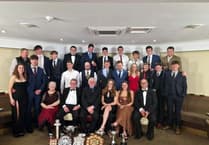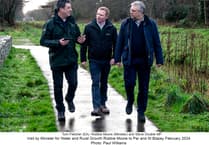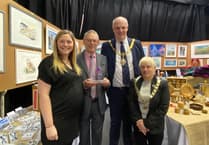Ray Roberts’ latest Nature Watch walk sees him apprehended by all sorts of wildlife in the lanes....
I received a call from an old friend in Menheniot who had found a large, fat caterpillar on a fuchsia bush in his front garden. I drove over to the village for a look and saw that it was an elephant hawk-moth caterpillar about 60mm long with large marking on its head that resemble eyes with a short, pointed tail. The moth, if you are lucky enough to spot one, has a pinkish body and wings that span 30 to 34mm.
The tiny crab apples on a short tree in the church car park looked ripe enough to eat although the one I tried was quite sharp to taste, but I photographed them anyway. Crab apples are said to be the parent of all cultivated apples and are planted nowadays as a decorative garden tree and hardly ever grow very tall. Birds consume the fruits and scatter their black seeds around gardens and seedlings are sometimes found in hedgerows where birds roost overnight.
I took a walk up Muddy Lane as I knew that several butterflies frequent the hedgerows and there was no chance of being run over when I stop to take a photograph after spotting something interesting. Firstly I was overtaken by a speckled wood, there are several on the wing nowadays and very often can be seen flying in twos and threes. This is a brown butterfly with lots of small white, yellow and black markings and is common in the south of England.
Then along came a smaller, more colourful butterfly that pitched at the foot of the hedge. It was a small copper with a wingspan of an inch (25mm). This little policeman was very friendly but he still arrested me for loitering around the lanes of Quethiock. I rang my wife to spring me from clink but she was talking on the phone as usual, so I sat there forlornly until she called my mobile to ask why my walk was taking so long!
There are loads of bright red clusters of hawthorn berries or haws on the trees now. More food for the birds, especially members of the thrush family, finches and tits. The berries are also important food for mice and other small animals.
Hawthorn trees were first used back in the 18th century to provide miles of hedges to divide fields, although nowadays these living hedges are being removed and replaced by wire fencing. I remember during the forties when I lived near Landrake the farm that we boys would roam around had several of these living hedges consisting of hawthorn and blackthorn that produced fruit, sloes, but the haws never appeared on the closely clipped hedges that were impossible to walk or crawl through.
Lots of honeysuckle flowers with their strong, sweet fragrance are to be seen in the lane, indeed everywhere around the village on their long climbing runners that twine around any nearby bush or tree. The scent becomes stronger as evening approaches which attracts night flying moths, especially many different hawk-moths.




